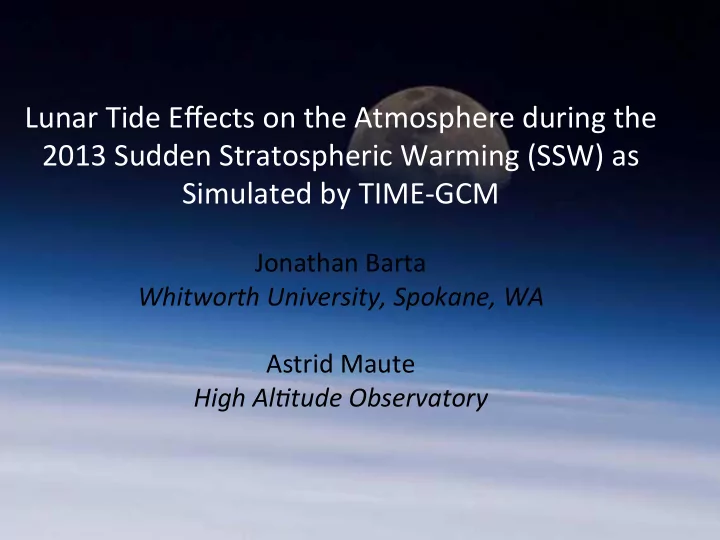

Lunar ¡Tide ¡Effects ¡on ¡the ¡Atmosphere ¡during ¡the ¡ 2013 ¡Sudden ¡Stratospheric ¡Warming ¡(SSW) ¡as ¡ Simulated ¡by ¡TIME-‑GCM ¡ ¡ Jonathan ¡Barta ¡ Whitworth ¡University, ¡Spokane, ¡WA ¡ ¡ ¡ Astrid ¡Maute ¡ High ¡Al8tude ¡Observatory ¡ ¡
Outline ¡ • Background ¡ ¡ • General ¡effects ¡of ¡the ¡lunar ¡Kde ¡during ¡SSW ¡ • Comparison ¡with ¡past ¡SSW ¡events ¡and ¡other ¡ models ¡ • Conclusion ¡
Sudden ¡Stratospheric ¡Warming ¡ Eastward ¡winds ¡of ¡the ¡polar ¡vortex ¡are ¡slowed ¡and ¡someKmes ¡even ¡reversed ¡in ¡ • the ¡winterKme, ¡leading ¡to ¡an ¡increase ¡in ¡stratospheric ¡temperature ¡in ¡the ¡winter ¡ polar ¡region. ¡ Main ¡Mechanism: ¡ • ¡ShiR/split ¡of ¡the ¡polar ¡vortex ¡with ¡respect ¡to ¡the ¡geographic ¡pole ¡and ¡planetary ¡waves ¡ ¡propagaKng ¡upwards. ¡ ¡
M2, ¡N2, ¡SW2 ¡Tides ¡ M2: ¡Principle ¡lunar ¡semidiurnal ¡Kde ¡ • – Period: ¡12.42 ¡hours ¡ N2: ¡Larger ¡lunar ¡ellipKc ¡semidiurnal ¡Kde ¡ • – Period: ¡12.66 ¡hours ¡ SW2: ¡MigraKng ¡solar ¡semidiurnal ¡Kde ¡ • – Period: ¡12 ¡hours ¡ ¡ ¡ • Lunar ¡Kme ¡is ¡slower ¡than ¡solar ¡ Kme. ¡ • τ ¡= ¡0.966 ¡t s ¡ ¡ ¡
TIME-‑GCM ¡Model ¡ Thermosphere ¡Ionosphere ¡Mesosphere ¡Electrodynamics ¡General ¡ • CirculaKon ¡Model ¡ Numerical ¡model ¡for ¡Earth’s ¡middle ¡and ¡upper ¡atmosphere ¡ • Uses ¡a ¡finite ¡differencing ¡technique ¡to ¡obtain ¡the ¡soluKon ¡to ¡the ¡non-‑ • linear ¡equaKons ¡defining ¡atmospheric ¡dynamics. ¡ Lower ¡boundary ¡and ¡background ¡are ¡specified ¡using ¡WACCMX ¡ ¡ • Ran ¡2 ¡simulaKons ¡with ¡TIME-‑GCM: ¡one ¡that ¡includes ¡lunar ¡Kde ¡and ¡one ¡ • that ¡doesn’t. ¡ Difference?! ¡ • ¡
Our ¡Focus: ¡Air ¡Density ¡in ¡the ¡Upper ¡Atmosphere ¡
Explain ¡why ¡the ¡temperature ¡increase. ¡Future ¡work? ¡ ConnecKon ¡between ¡density ¡and ¡ temperature ¡ • Low ¡alt: ¡both ¡temp ¡and ¡density ¡are ¡increased/decreased ¡by ¡about ¡2% ¡due ¡ to ¡the ¡lunar ¡Kde ¡ • High ¡alt: ¡Density ¡is ¡affected ¡22% ¡at ¡max, ¡temp ¡only ¡affected ¡about ¡5-‑6% ¡ PerturbaKons ¡in ¡density ¡ and ¡temperature ¡are ¡ similar. ¡ -‑CorrelaKon ¡coefficient: ¡ 0.67 ¡
LaKtude ¡vs. ¡Time ¡
Other ¡stuff ¡must ¡be ¡going ¡on… ¡ Possible ¡causes ¡of ¡ anomalies: ¡ -‑Could ¡be ¡due ¡to ¡Kdes ¡ dissipate, ¡change ¡ composiKon ¡ -‑AdiabaKc ¡heaKng/cooling ¡ (look ¡at ¡temp ¡and ¡verKcal ¡ wind ¡background) ¡ l ¡ ¡l ¡l ¡ -‑Tidal ¡mixing ¡can ¡change ¡ densiKes ¡
Move ¡point ¡with ¡Forbes? ¡Add ¡global ¡mean ¡density ¡plot ¡and ¡connect ¡Kmes. ¡ M2, ¡N2, ¡SW2 ¡Amplitudes ¡ • All ¡three ¡Kdes ¡peak ¡during ¡SSW, ¡and ¡all ¡show ¡periodicity. ¡ ¡ • However, ¡M2 ¡and ¡N2 ¡peak ¡sharply ¡due ¡to ¡the ¡amplificaKon ¡of ¡lunar ¡Kdes ¡ during ¡SSW ¡(due ¡to ¡resonance. ¡Forbes ¡2013). ¡ • N2 ¡peaks ¡about ¡10 ¡days ¡aRer ¡M2. ¡This ¡delay ¡is ¡noted ¡by ¡Forbes ¡et ¡al. ¡during ¡ the ¡2009 ¡SSW ¡event. ¡Thus ¡this ¡is ¡possibly ¡a ¡consistent ¡feature ¡in ¡SSW ¡events. ¡ The ¡cause ¡would ¡need ¡further ¡research. ¡ ¡
Make ¡scales ¡the ¡same? ¡Yes ¡ Comparison ¡with ¡observed ¡data ¡ ¡ SABER ¡(Sounding ¡of ¡the ¡Atmosphere ¡using ¡Broadband ¡Emission ¡Radiometry) ¡is ¡an ¡ • Instrument ¡on ¡NASA’s ¡TIMED ¡satellite. ¡ Good ¡agreement ¡is ¡seen ¡in ¡the ¡temporal ¡change ¡of ¡M2 ¡amplitudes ¡for ¡different ¡ • laKtudes. ¡ However! ¡Discrepancies ¡are ¡definitely ¡seen. ¡ ¡
Comparison ¡with ¡GSWM ¡from ¡2009 ¡ • M2 ¡peaks ¡near ¡30 o N ¡and ¡ 30 o S. ¡ ¡ • Similar ¡amplitude ¡ranges. ¡ • 2009 ¡GSWM ¡had ¡largest ¡ peak ¡in ¡northern ¡ hemisphere ¡while ¡2013 ¡ TIME-‑GCM ¡was ¡southern. ¡ -‑ ¡Could ¡be ¡due ¡to ¡different ¡ SSW ¡events ¡or ¡different ¡ models ¡ Reference: ¡Forbes, ¡J. ¡M., ¡and ¡Zhang, ¡X. ¡(2012), ¡Lunar ¡Kde ¡ amplificaKon ¡during ¡the ¡January ¡2009 ¡stratosphere ¡warming ¡event: ¡ ObservaKons ¡and ¡theory, ¡ Journal ¡of ¡Geophysical ¡Research, ¡117, ¡ A12312. ¡ ¡
Effects ¡of ¡other ¡Kdes ¡ • Large ¡influence ¡from ¡waves ¡with ¡zonal ¡wavenumber ¡= ¡2 ¡(M2, ¡N2, ¡SW2) ¡ • Slight ¡effect ¡from ¡waves ¡with ¡zonal ¡wavenumber ¡= ¡0 ¡and ¡3. ¡ ¡ ¡ ¡
Change ¡to ¡Liu ¡paper ¡and ¡make ¡new ¡days ¡for ¡UN ¡ Background ¡wind ¡ ¡ ¡ ¡ ¡2013 ¡background ¡UN ¡ ¡ ¡ ¡ ¡ ¡ ¡ ¡ ¡ ¡ ¡ ¡ ¡ ¡ ¡ ¡ ¡ ¡ ¡ ¡ ¡ ¡ ¡ ¡ ¡ ¡ ¡ ¡ ¡2009 ¡M2 ¡UN ¡amp ¡ ¡ • TIME-GCM simulated zonal winds before and during the 2013 SSW compared to GAIA zonal winds before and during the 2009 SSW. ¡ ¡ Liu, ¡H. ¡et ¡al. ¡(2014), ¡ Thermal ¡and ¡dynamical ¡changes ¡of ¡the ¡zonal ¡mean ¡state ¡ of ¡the ¡thermosphere ¡during ¡the ¡2009 ¡SSW: ¡GAIA ¡simulaKons, ¡ Journal ¡of ¡ Geophysical ¡Research: ¡Space ¡Physics, ¡ JA020222. ¡ ¡
Background ¡wind ¡through ¡Kme ¡
Conclusions ¡ • Can use the model because with lunar tides it compares favorably with observation (and other models). Thus one can use it to look isolate lunar tide effects by differencing a simulation with lunar tides and one without lunar tides. • Density was affected by upwards of 20% due to lunar tides at an altitude of 400km, and up to 14% at 150km near the poles (surprisingly large effects). – Further Research: • The mechanisms for the enhancements observed during SSW are still unknown. Density variation could be due to background wind circulation, tide dissipation, composition mixing, etc. • How the lunar tides propagate and why a stronger response is seen in the southern hemisphere. Forcing at the lower boundary is symmetric over the equator, so probably some background is causing change as waves propagate upwards.
Thanks ¡to…. ¡ My ¡Mentor, ¡Astrid ¡Maute! ¡ ¡ Maura ¡Hagan ¡and ¡Art ¡Richmond ¡for ¡helping ¡us ¡along ¡the ¡way ¡ (They ¡were ¡all ¡paKent ¡bears) ¡
Recommend
More recommend